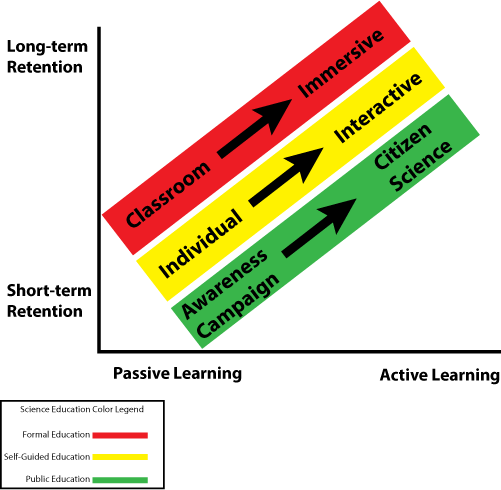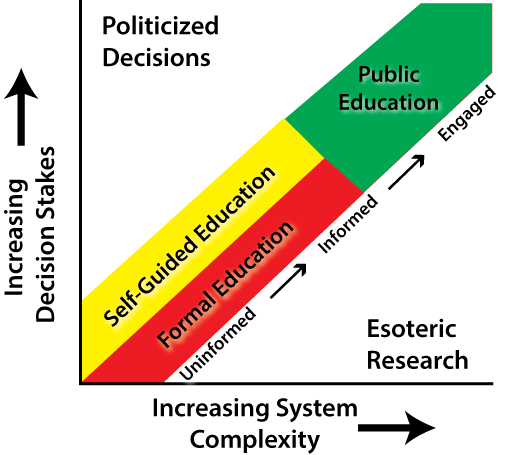Converting from passive to active learning
Bill Dennison ·There are many different forms of education and just as many different ways to categorize different forms of education. We have chosen a fairly simplistic three category scheme; formal education, self-guided education and public education. What we mean by formal education is the education provided through schools and universities. This form of education has historically been with students and teachers in classrooms. What we mean by self-guided education is sometimes known as 'informal education' and it is the education that people obtain through visits to parks, museums, aquaria and other means of obtaining information via signage, interpreters, rangers, docents, guides, etc. What we mean by public education is when the 'student' actively engages in learning through citizen science programs, participatory science and experimentation. In popular education, the lines between the 'teacher' and 'student' blur and learning occurs by both 'teacher' and 'student'.

Passive learning in which the teacher drones on in front of a classroom while students take notes or daydream is not particularly effective, particularly with regard to long-term retention of the material. The adage "see it and forget it", "hear it and remember it", and "do it and learn it" is appropriate regarding passive learning. In formal education, a way to convert passive learning into active learning is to invoke immersive education. In self-guided education, a way to convert passive learning into active learning is to convert individual viewing into an interactive experience, often with groups of people. In public education, a way to convert passive learning which can be through an awareness campaign is to develop citizen scientists. The focus is on getting people to become more engaged in the educational process.

There is a role in society for each of these education modes (formal, self-guided, public). We have established a rough guide as to when these different modes are best utilized by contrasting the system complexity (How complex is the topic?--learning to perform calculations vs. learning to balance multiple goals) with decision stakes (How important is the answer?--does it affect only the student grades or does it affect people's lives?). With low system complexity and low decision stakes, both formal and self-guided education can be fully adequate in their ability to convert uninformed or untrained people into informed and trained people. With increasing system complexity and increasing decision stakes, converting from passive to active learning becomes increasingly important, thus immersive and interactive education approaches are more relevant. In addition, public education really is needed to fully engage people in the educational process. In situations that are truly complex, but the decision stakes are not very high, 'esoteric' research can be employed in which basic principles can be derived through research projects but people's lives are not directly or immediately affected. In simple systems with high decision stakes, it is the role of the political leaders to make decisions acceptable to the public.

Our experience with these different forms of education has led to the development of three different chapters; two published in the Journal of Contemporary Water Research & Education and one published as a two part blog series on the IAN website. In these chapters, we discuss public education, immersive education and science communication, drawing inferences from a suite of personal case studies.
About the author
Bill Dennison

Dr. Bill Dennison is a Professor of Marine Science and Vice President for Science Application at the University of Maryland Center for Environmental Science.

